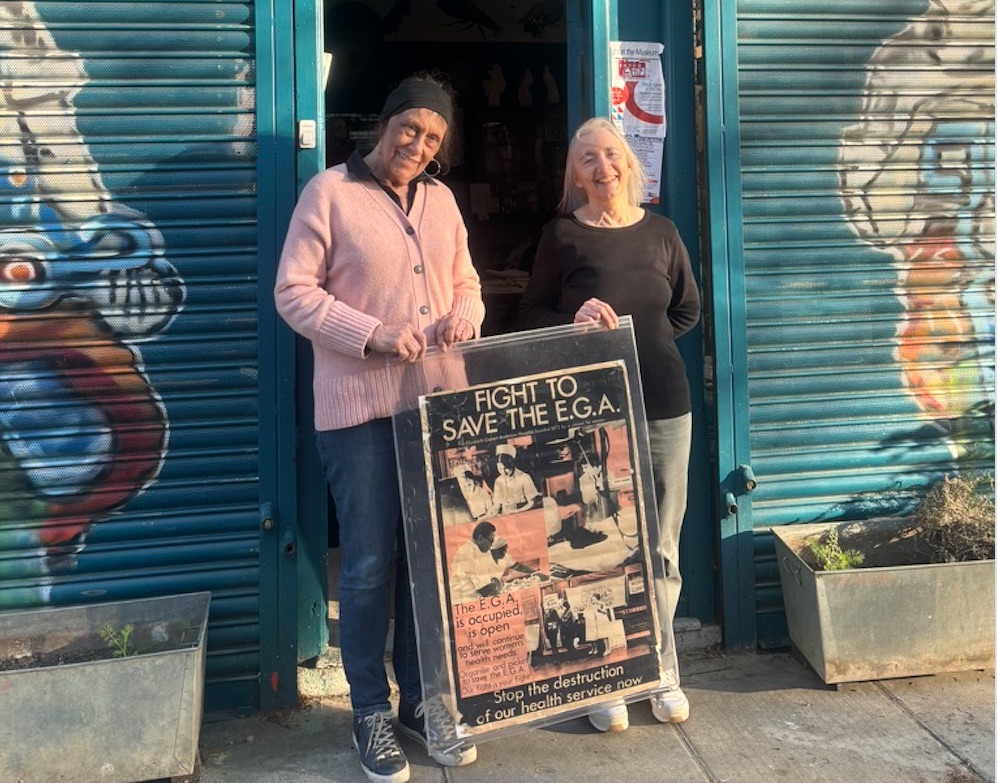50 years on, the campaign that saved a hospital
Special event reflects on the spirited campaign to stop closure
Thursday, 10th April 2025 — By Ottoline Spearman

Linda Clarke and Lynn MacRitchie at the Somers Town People’s Museum
IT’S November 1976, and a group of campaigners have staged an occupation at the Elizabeth Garrett Anderson hospital on the Euston Road.
This is Britain’s first hospital “work-in”, with protestors demonstrating against plans to close the UK’s first women’s hospital.
Under the then Labour government, a wave of cuts to social services had been tabled, including a proposal to close 120 of the 150 hospitals in London.
The Elizabeth Garrett Anderson (EGA) – founded in 1872 and later named after the UK’s first female doctor – was among the hospitals under threat.
While the hospital played a unique and vital role in women’s health care, offering services to working class women delivered by qualified women doctors, changes in administration and years of neglect had begun to hasten its decline.
Upon visiting the hospital in the 1970s, Social Services Secretary Barbara Castle described the EGA as a “small, uneconomic building in an expensive location”. Its recognition as a nurse training establishment was subsequently withdrawn, prompting a crisis about the hospital’s future, and in February 1976, Castle announced its closure.
So began a tireless campaign to save the hospital.
Nearly 50 years on, two of the people who helped the fight will speak about their experiences at the Somers Town People’s Museum this evening (Thursday).
“The women’s movement was very powerful at that time and it had been very concerned with raising issues about women’s health, which was kind of ignored within the health establishment,” said Lynn MacRitchie, who joined the campaign while working at the Royal Free Hospital.
Linda Clarke, secretary of the campaign, the closures were part of the Labour government’s plan to even out the services throughout the country.
“It was very questionable, the whole policy of closures everywhere. And it was all really austerity, like we have now,” she said.
The “Save the EGA” campaign was comprised of representatives from a wide range of groups, including trade unions, trades councils, nurses and doctors, and women’s groups.
The Day of Action in July 1976, where 2000 people went on strike in a bid to save the EGA, was key to the campaign’s success. One thousand hospital workers from the EGA and neighbouring hospitals went on strike, with a picket set up outside the EGA.
A further 1,000 people descended on the Houses of Parliament, marching through the streets from the hospital, and a lobby meeting of over 300 people met MPs to protest their grievances.

With pressure mounting for the hospital to be closed, in November 1976, an occupation began, where doctors, nurses, and trade union members occupied the hospital for over a year – not to disrupt services, but to ensure that they kept running.
A 24-hour picket line was set up outside the hospital, maintained through a shift system, where trade unions, trades councils and women’s groups rotated in four-hour shifts.
“We wouldn’t take no for an answer,” said Ms Clarke, who played a major part in bringing women to the picket line. “I think it used up a year of my life really. “It was an extraordinary thing to be part of.”
Commenting on the recent closure of the maternity wing at the Royal Free Hospital, Ms MacRitchie said: “We’re facing a similar situation, if not rather worse now. It’s harder to lobby. The trade union movement was a real thing – it was real people turning up”.
The People’s Museum of Somers Town will be holding an event tonight from 6pm to commemorate the campaign, including the screening of a film.